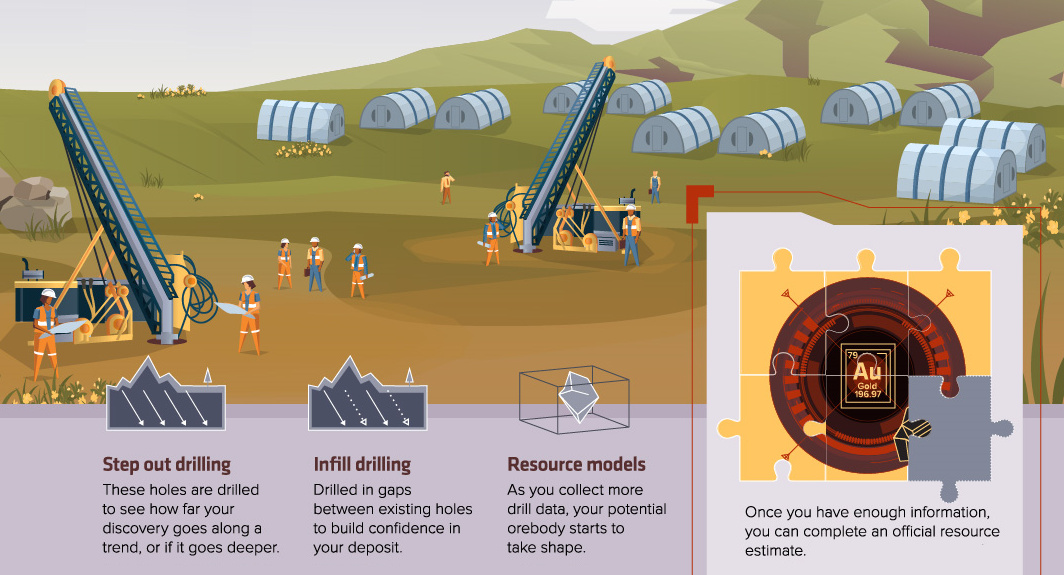Mining
The Mineral Exploration Roadmap

Mineral Exploration Roadmap
There is nothing more exciting than making some type of discovery.
Discoveries can come in many forms – they can be physical, scientific, personal, or even philosophical in nature. But while there are different types of discoveries that can be made, perhaps the most tactile kind of discovery is in the field of mineral exploration.
The discovery of a mineral deposit can transform a piece of “moose pasture” into a new economic asset, and it may enable millions or billions of dollars worth of metals and minerals to be used for human purposes.
These minerals get used all around us – they go into our houses, cars, infrastructure, jewelry, electronics, and they can even be used to power the green revolution.
From Prospecting to Production
Making an economic mineral discovery is the goal of many teams around the world, but these efforts can also be extremely difficult, costly, and time-consuming, and most companies engaged in exploration end up walking away empty-handed.
Today’s infographic comes to us from Orix Geoscience and it shows the steps of mineral exploration, and how teams can maximize their odds of success by using data to add value throughout the process.
Steps of the Mineral Exploration Process
1. Exploration Strategy
Where do you choose to explore? There are two basic strategies:
(a) Working from the known
Deposits tend to form in clusters in prolific belts, and exploration occurs outward from known mineralization.
(b) Working from the unknown
If you review all available information, prospective areas with potential for discoveries can be identified.
2. Prospecting
In this stage, boots are now on the ground – and it’s time to explore the backwoods for showings. Prospectors will stake claims, map outcrops and showings, and search for indicator minerals.
The goal of the prospecting stage is to find the earliest piece of the exploration puzzle: the clue that there is something much bigger beneath.
3. Early-Stage Exploration
Congrats, you’ve found something interesting – and now it’s time to ramp up exploration efforts!
This is where the amount of data and sophistication picks up. In this stage, companies are using existing maps and historical data, geophysics, ground truthing, geochemistry, and trenching to try and identify drill targets.
4. The “Truth Machine”
Geologists don’t call the drill a “truth machine” for nothing.
If you’re target hits, you’re in business. If your target misses, it’s time to go back a step and find new ones.
5. Discovery
Eureka! You’ve found something. Now it’s time to see how far the mineralization goes!
Once you have enough information, you can get an official resource estimate. This data is another puzzle piece that will be crucial as you advance your discovery.
6. De-risking
Even at the best of times, mining can be expensive, risky, and tricky.
That’s why your investors and backers will want you to source even more data – it’ll allow you to see a clearer picture of the deposit, and help your team see how it could take shape as a mine.
At this stage, drilling, metallurgical tests, environmental assessments, 3d models, and mine designs are used to increase confidence in the project.
Data starts to get very granular. Your company may do a Preliminary Economic Assessment (PEA) to assess the potential economic outcomes of a mine. Then after, they may conduct an in-depth Feasibility Study to help make a production decision.
Final Steps
By this point, you may have all the puzzle pieces – a clear vision of the deposit and its potential – to make a decision!
If the puzzle looks good, it’s time to make a production decision, construct the mine, and start commercial production. But the data doesn’t stop there – at these later stages, even more data gets created and it can help you make better decisions.
Lithium
Ranked: The Top 10 EV Battery Manufacturers in 2023
Asia dominates this ranking of the world’s largest EV battery manufacturers in 2023.

The Top 10 EV Battery Manufacturers in 2023
This was originally posted on our Voronoi app. Download the app for free on iOS or Android and discover incredible data-driven charts from a variety of trusted sources.
Despite efforts from the U.S. and EU to secure local domestic supply, all major EV battery manufacturers remain based in Asia.
In this graphic we rank the top 10 EV battery manufacturers by total battery deployment (measured in megawatt-hours) in 2023. The data is from EV Volumes.
Chinese Dominance
Contemporary Amperex Technology Co. Limited (CATL) has swiftly risen in less than a decade to claim the title of the largest global battery group.
The Chinese company now has a 34% share of the market and supplies batteries to a range of made-in-China vehicles, including the Tesla Model Y, SAIC’s MG4/Mulan, and various Li Auto models.
| Company | Country | 2023 Production (megawatt-hour) | Share of Total Production |
|---|---|---|---|
| CATL | 🇨🇳 China | 242,700 | 34% |
| BYD | 🇨🇳 China | 115,917 | 16% |
| LG Energy Solution | 🇰🇷 Korea | 108,487 | 15% |
| Panasonic | 🇯🇵 Japan | 56,560 | 8% |
| SK On | 🇰🇷 Korea | 40,711 | 6% |
| Samsung SDI | 🇰🇷 Korea | 35,703 | 5% |
| CALB | 🇨🇳 China | 23,493 | 3% |
| Farasis Energy | 🇨🇳 China | 16,527 | 2% |
| Envision AESC | 🇨🇳 China | 8,342 | 1% |
| Sunwoda | 🇨🇳 China | 6,979 | 1% |
| Other | - | 56,040 | 8% |
In 2023, BYD surpassed LG Energy Solution to claim second place. This was driven by demand from its own models and growth in third-party deals, including providing batteries for the made-in-Germany Tesla Model Y, Toyota bZ3, Changan UNI-V, Venucia V-Online, as well as several Haval and FAW models.
The top three battery makers (CATL, BYD, LG) collectively account for two-thirds (66%) of total battery deployment.
Once a leader in the EV battery business, Panasonic now holds the fourth position with an 8% market share, down from 9% last year. With its main client, Tesla, now sourcing batteries from multiple suppliers, the Japanese battery maker seems to be losing its competitive edge in the industry.
Overall, the global EV battery market size is projected to grow from $49 billion in 2022 to $98 billion by 2029, according to Fortune Business Insights.
-

 Education1 week ago
Education1 week agoHow Hard Is It to Get Into an Ivy League School?
-

 Technology2 weeks ago
Technology2 weeks agoRanked: Semiconductor Companies by Industry Revenue Share
-

 Markets2 weeks ago
Markets2 weeks agoRanked: The World’s Top Flight Routes, by Revenue
-

 Demographics2 weeks ago
Demographics2 weeks agoPopulation Projections: The World’s 6 Largest Countries in 2075
-

 Markets2 weeks ago
Markets2 weeks agoThe Top 10 States by Real GDP Growth in 2023
-

 Demographics2 weeks ago
Demographics2 weeks agoThe Smallest Gender Wage Gaps in OECD Countries
-

 Economy2 weeks ago
Economy2 weeks agoWhere U.S. Inflation Hit the Hardest in March 2024
-

 Green2 weeks ago
Green2 weeks agoTop Countries By Forest Growth Since 2001














